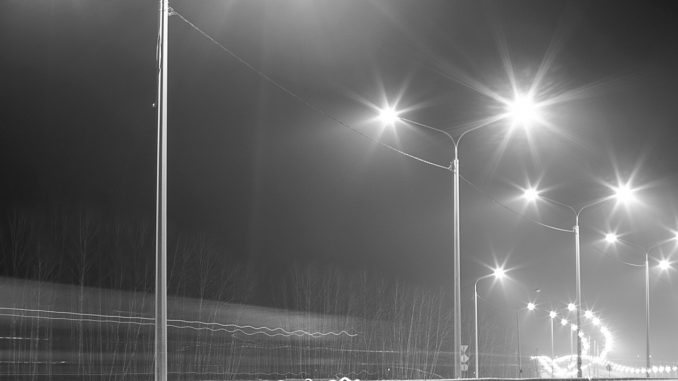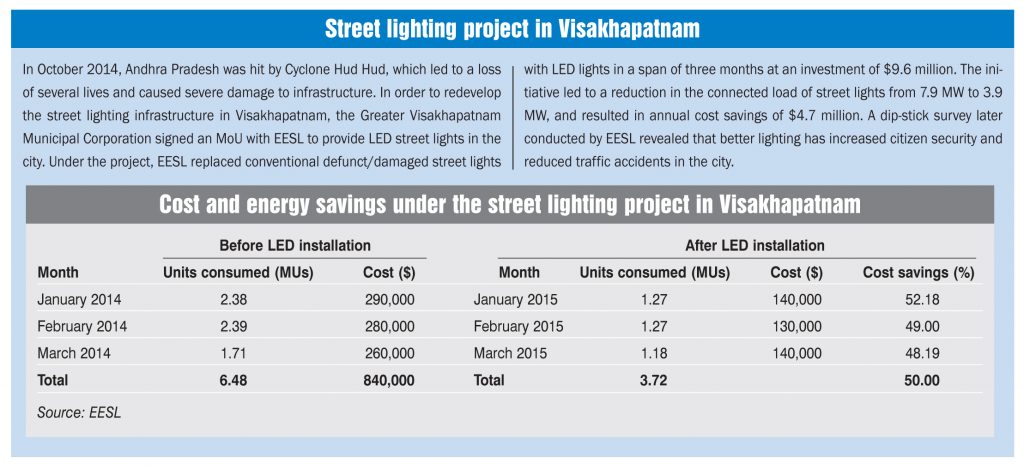
Street lighting is an essential community asset that helps improve security in both urban and rural areas and road safety for vehicles moving in the night-time. The country has long relied on sodium lamps for street lighting but given their high energy consumption, alternatives such as LEDs are being explored. LEDs can provide a better lighting experience with one-fourth of the wattage required in sodium lamps and also have a longer lifespan. Energy efficient lighting solutions are gaining traction given the high energy consumption of the public lighting sector. As per the Central Electricity Authority’s 18th Electric Power Survey, the estimated energy consumption of the Indian public lighting sector stood at 8,478 MUs in 2012-13 and it is increasing at a compound annual growth rate of 7 per cent.
In order to reduce energy costs and promote energy efficiency, the government is pushing for the conversion of all street lights into LEDs. To this end, the prime minister launched the Street Lighting National Programme (SLNP) on January 5, 2015. The programme, spearheaded by Energy Efficiency Services Limited (EESL), aims to replace about 14 million conventional street lights in the country with smart LEDs by 2019. In August 2017, the SLNP achieved an important milestone with the installation of over 3 million LED street lights along 50,000 km of roads across the country to become the world’s largest street light management company.
As of April 2018, the installation of about 5.6 million LED street lights has been completed by EESL under the programme. This implies average energy savings of about 270 kWh per light per year. It also corresponds to 1.25 million tonnes (mt) of carbon dioxide emission reduction per year and nearly 378 MW of avoided peak demand. The street lighting projects under the programme have been classified into five types – state-level projects, state and gram panchayat projects, individual urban local body (ULB) projects, institutional projects, and projects under discussion. All states are covered under the first four categories, except the five north-eastern states (Arunachal Pradesh, Nagaland, Manipur, Mizoram and Meghalaya), where street lighting projects are currently under discussion.
Andhra Pradesh is leading amongst states, with the installation of nearly 1.1 million street lights. In June 2017, it became the first state in India to implement the rural LED street lighting project under the SLNP. Under the project, the state government, along with EESL, will replace about 1 million conventional street lights with LED lights in villages across seven districts in Andhra Pradesh Guntur, Prakasam, Nellore, Kurnool, Kadapa, Anantapur and Chittoor. The initiative will help save about 147 MUs of electricity annually and lead to a carbon dioxide (CO2) emission reduction of 1.2 mt. The upfront capital cost of the project is being funded by the French Development Agency, Agence Française de Développement.
The states of Rajasthan, Gujarat and Telangana have also made significant progress with the installation of over 0.91 million, 0.83 million and 0.78 million street lights respectively. Uttar Pradesh and Delhi follow next with the installation of 0.56 million and 0.3 million street lights respectively.
Overall, the programme is progressing at a brisk pace with EESL retrofitting nearly 15,000 conventional lights with LED street lights every day. The programme is nearing completion in Himachal Pradesh, Tripura and Gujarat. EESL is also implementing a special heritage lighting project in the Kashi region of Uttar Pradesh where 4,000 lights are being installed. Recent additions to the SLNP include Chandigarh and Port Blair, Andaman & Nicobar Islands.
Under the SLNP, EESL is undertaking the projects at its own cost, without any investment from ULBs and municipal corporations. The contracts between EESL and ULBs/municipal corporations are for a duration of seven years. Under the contracts, the former assures a minimum energy saving of 50 per cent, and provides free replacement and maintenance of LEDs. The ULBs/municipal corporations pay back to EESL with the cost savings achieved due to energy reduction during the period.
LED price and specifications
Owing to their large-scale procurement under the SLNP, LED street lights have witnessed a 40 per cent decline in costs from Rs 135 per watt to Rs 80 per watt. EESL installs smart LED lights equipped with the central control monitoring system (CCMS), which provides a remote monitoring and operation facility. The system ensures that street lights are automatically turned on at dusk and turned off after dawn. The CCMS also sends alerts regarding possible faults in street lights to facilitate preventive maintenance and reduce unexpected breakdowns. Further, it monitors the energy consumption of street lights to ascertain the benefits of the project.
The LED street lights procured by EESL conform to the Bureau of Indian Standards specification and have a seven-year warranty against technical defects. Adequate quality checks are conducted from the bidding stage to the field/ installation level. As a result, the installed LEDs deliver superior performance with an overall technical fault level of less than 2 per cent and an uptime of 97 per cent.
The way ahead
The SLNP has given a boost to energy efficient street lighting systems. Today, street lighting is driving the growth of LEDs in the country. The wide participation by states and ULBs reflects the programme’s achievements so far. Further, many social audits by EESL at project sites have demonstrated impressive results with regard to consumer satisfaction and safety.


